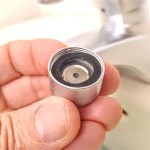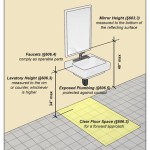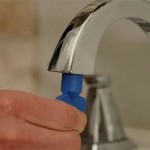What Size Backsplash is Ideal for Your Bathroom Vanity Unit?
Selecting the correct backsplash size for a bathroom vanity unit is a crucial design decision that impacts both the aesthetic appeal and the functional protection of the space. A backsplash serves as a barrier against water damage, preventing moisture from seeping into the wall behind the vanity. It also provides an opportunity to enhance the overall style of the bathroom, complementing the vanity, countertop, and other fixtures. Determining the appropriate size involves considering several factors, including the vanity dimensions, the height of the faucet, the overall bathroom design, and personal preferences.
The backsplash is not merely a decorative element; it is a practical necessity. Without a properly sized backsplash, water splashes from the sink can gradually damage the wall, leading to mold growth, peeling paint, and costly repairs. A well-chosen backsplash acts as a protective shield, ensuring the longevity and integrity of the bathroom's structure. Choosing the correct size is essential for maximizing its effectiveness.
Determining the Standard Backsplash Height
The most common backsplash height for a bathroom vanity unit is typically 4 inches. This dimension provides adequate protection against everyday splashes and spills while maintaining a clean and streamlined appearance. A 4-inch backsplash often aligns visually with the height of standard electrical outlets and light switches, creating a cohesive and balanced look. This size is a safe and versatile choice that works well in a variety of bathroom styles, from traditional to contemporary. It serves as a minimalist barrier, preventing water damage without overpowering the rest of the vanity area. Many pre-fabricated vanity units come with a detachable 4-inch backsplash included, simplifying the installation process.
While 4 inches is a common standard, the ideal height often depends on the specific needs and design preferences of the homeowner. For instance, if the vanity countertop is prone to more significant splashing due to a forceful faucet or frequent use by children, a slightly taller backsplash, perhaps 6 inches, could be more appropriate. Conversely, in minimalist designs where a cleaner, less noticeable barrier is desired, a shorter backsplash, around 2-3 inches, might be preferred. It’s important to consider the specific usage patterns of the bathroom and the desired aesthetic before settling on a standard height.
Furthermore, the type of countertop material can also influence the ideal backsplash height. For instance, if the countertop is made of a porous material like natural stone, a taller backsplash is typically recommended to provide additional protection against staining and water damage. This is because porous materials are more susceptible to absorbing liquids, and a taller backsplash can help prevent water from seeping into the countertop and causing discoloration. Conversely, if the countertop is made of a non-porous material like quartz or solid surface, a shorter backsplash may be sufficient.
Considering the Faucet Height and Style
The height and style of the faucet are critical factors to consider when determining the appropriate backsplash size. A taller faucet, particularly a vessel faucet or a widespread faucet with a high arc, requires a higher backsplash to effectively prevent water from splashing onto the wall. If the backsplash is too short, water can easily splash over the top, rendering it ineffective. As a general rule, the backsplash should extend at least a few inches above the highest point where water is likely to splash from the faucet.
Before finalizing the backsplash size, it is essential to install the faucet and test its range of motion. Turn the faucet on at different water pressures and observe the splash pattern. This will help determine the minimum height required to adequately protect the wall. If the faucet tends to cause excessive splashing, consider opting for a taller backsplash or adjusting the water pressure to minimize splashing. The goal is to strike a balance between practicality and aesthetics, ensuring that the backsplash effectively protects the wall without obscuring the faucet.
The faucet style also influences the overall design of the backsplash. For instance, a wall-mounted faucet eliminates the need for faucet holes in the countertop, allowing for a seamless and uninterrupted backsplash design. In this case, the backsplash can be extended to the full height of the wall, creating a dramatic and visually striking effect. Conversely, if the faucet is mounted on the countertop, the backsplash can be designed to wrap around the faucet base, creating a cohesive and integrated look. The faucet style should be carefully considered alongside the backsplash design to achieve a harmonious and balanced aesthetic.
Exploring Full Backsplash Options
While standard backsplash heights typically range from 4 to 6 inches, some homeowners opt for a full backsplash that extends all the way up to the ceiling. This design choice offers maximum protection against water damage and can create a dramatic and luxurious aesthetic. A full backsplash is particularly well-suited for smaller bathrooms, as it can visually expand the space and create a sense of height. It also provides a seamless and easy-to-clean surface, minimizing the maintenance required to keep the bathroom looking its best. However, full backsplashes generally demand more resources, in terms of materials and installation costs.
A full backsplash can be achieved using a variety of materials, including tile, stone, and glass. Tile is a popular choice due to its durability, water resistance, and wide range of colors and patterns. Stone, such as marble or granite, offers a luxurious and timeless aesthetic, while glass creates a sleek and modern look. The material chosen for the full backsplash should complement the overall design of the bathroom and be carefully selected to ensure durability and ease of maintenance. Some homeowners choose to extend the countertop material as a full backsplash for a unified aesthetic.
When considering a full backsplash, it is important to plan the layout carefully. The backsplash should be installed symmetrically and align with the surrounding walls and fixtures. If the bathroom has any architectural features, such as windows or niches, the backsplash should be designed to accommodate these features seamlessly. Additionally, the placement of electrical outlets and light switches should be carefully considered to ensure they are easily accessible and do not detract from the overall aesthetic. Proper planning and execution are essential for achieving a visually appealing and functional full backsplash.
Another consideration when opting for a full backsplash is the impact on the overall lighting in the bathroom. A dark-colored backsplash can absorb light, making the bathroom appear darker and smaller. Conversely, a light-colored backsplash can reflect light, creating a brighter and more spacious feel. It is important to choose a backsplash color that complements the existing lighting in the bathroom and enhances the overall ambiance. Adequate lighting should also be incorporated into the design to ensure that the backsplash is properly illuminated.
Beyond the aesthetic considerations, a full backsplash provides practical benefits, particularly in high-moisture environments. It creates a continuous barrier against water, preventing moisture from seeping into the wall cavity and causing mold and mildew growth. This is especially important in bathrooms with poor ventilation or frequent use of showers and tubs. A full backsplash can also help to insulate the bathroom, reducing energy costs and creating a more comfortable environment. It is a worthwhile investment for homeowners seeking to protect their bathroom from water damage and improve the overall quality of their living space.
The decision to opt for a full backsplash often hinges on the homeowner's budget and design preferences. While it may be more expensive than a standard backsplash, the benefits it offers in terms of protection and aesthetics can make it a worthwhile investment. Ultimately, the ideal backsplash size should be carefully considered based on the specific needs and design of the bathroom, ensuring a functional and visually appealing space.
Ultimately, determining the appropriate backsplash size involves a comprehensive assessment of the vanity dimensions, faucet height and style, bathroom design, and personal preferences. A well-chosen backsplash protects the wall from water damage and enhances the overall aesthetic of the bathroom. Whether opting for a standard 4-inch backsplash, a taller backsplash to accommodate a high faucet, or a full backsplash for maximum protection and visual impact, the key is to carefully consider all the factors involved and make an informed decision that aligns with the specific needs and design goals of the homeowner.

29 Bathroom Backsplash Height Best For

29 Bathroom Backsplash Height Best For

Do Bathroom Vanities Need A Backsplash

Do You Need A Backsplash For Your Bathroom Vanity Diamond Kitchen Bath

A Bathroom Backsplash Is It Worth Installing On Your Vanity

29 Bathroom Backsplash Height Best For

A Bathroom Backsplash Is It Worth Installing On Your Vanity

A Bathroom Backsplash Is It Worth Installing On Your Vanity

A Better Alternative To 4 Inch Tall Backsplash

29 Bathroom Backsplash Height Best For
Related Posts







